

I V N E U R S E I H T Y T O H F G R E U D B I N The Diagrammatic Coaction Einan Gardi (Higgs Centre, Edinburgh) In collaboration with: Samuel Abreu, Ruth Britto, Claude Duhr and James Matthew References: Phys.Rev.Lett. 119 (2017) no.5, 051601, JHEP 1706 (2017) 114 , JHEP 1712 (2017) 090 and work to appear soon
The Diagrammatic Coaction: Motivation • Many Feynman diagrams evaluate to Multiple polylogarithms (MPLs). MPLs admit a coaction, which maps complicated objects into simpler ones. The coaction has many applications including simplifying expressions and taking discontinuities. • Can Feynman integrals themselves be endowed with a coaction? The idea that there should be a Hopf Algebra on Feynman graphs / integrals that reproduces the one on MPLs was an inspiration for research over many years [Kreimer, Brown]. • At one loop we now have an explicit construction in dimensional regularisation with a simple graphical interpretation involving contractions and cuts. • This algebraic structure encodes the analytic properties of the integrals. It facilitates e.g. performing analytic continuation and deriving di ff erential equations. It also provides a new perspective on cuts and Master Integrals. • Can it be extended to higher loops?
Recommend
More recommend